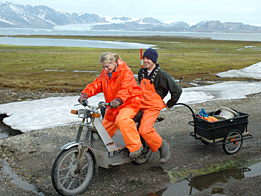Principal Investigators: Glenn Lopez, SoMAS; Will Ambrose, Bates College, Lewiston, Maine; Lisa Clough, East Carolina University, Greenville, North Carolina; Ming-Yi Sun, University of Georgia, Athens, Georgia
Funded by NSF Polar Programs
Project Description: Sea ice is a dominant feature of marine ecosystems in the Arctic. Its presence impacts Arctic marine ecosystems, especially on the shelves where benthic and pelagic systems are extensively coupled. If the extent and thickness of sea ice continue to decline, we predict a shift in the type of algal material reaching the benthos (from ice algae to phytoplankton), which will potentially change food delivery to the benthos. We have several pieces of evidence showing that ice algae (mostly diatoms) presently reach the benthos in significant quantities. What we don’t know, and what we are currently studying, is the relative digestibility of ice algae and phytoplankton-derived organic matter by the Arctic macrobenthos. From the perspective of an animal on the seabed, digestibility includes three separate components:
- selection (is encountered organic material ingested or rejected?)
- absorption (is ingested organic material absorbed during passage through the gut)
- assimilation (is absorbed organic material assimilated into biomass?)
We are assessing these processes by conducting fieldwork around the Svalbard Archipelago, in the Barents, and near Kotzebue, Alaska. We are conducting feeding experiments to measure short-term absorption, and analyzing algae, sediment, and benthic animals for lipid biomarkers and stable isotopic signatures to determine longer-term assimilation.






